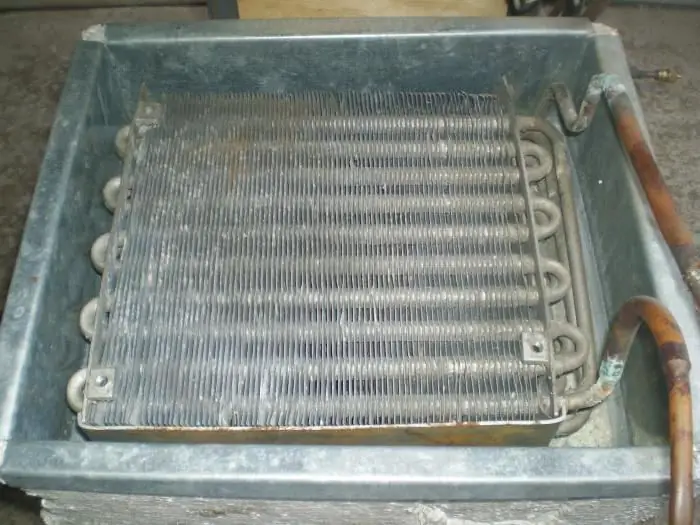2025 Author: Howard Calhoun | [email protected]. Last modified: 2025-06-01 07:12:56
Each element of the car needs careful care, and when it comes to operating the car in the winter, the battery requires special treatment. In the cold, its resource is significantly reduced. To be ready at any time to replace a failed power source and hit the road, keep a dry-charged battery on your shelf. This is the most durable and cheapest power element.
Dry charged battery
Batteries familiar to us arrive on the shelves in a charged state: an electrolytic solution (sulfuric acid) is already poured into a plastic container with lead plates inside.
Dry-charged batteries are empty on the market. They have a plastic shell with a lead reagent placed inside, but they do not contain an acid solution. This solution gives the source of electricity some advantages, the main of which is- possibility of long-term storage.

But before installing a dry-charged battery in a car, you need to bring it into working condition. To do this, you must always have an acid solution on hand and know certain rules for commissioning a battery.
Commissioning a dry-charged battery
The amount of acid needed to charge the battery depends on the type of device purchased. Usually this parameter varies between 1.5-5 liters. The only thing you can be sure of is that you will need more acid than the operating capacity of the battery.
The first thing to do is to depressurize the plastic shell. Do this in a clean technical room, because even a small amount of contaminants can ruin the installation. After that, start pouring electrolyte into a dry-charged battery until the top edge of the plate is under a 2-centimeter layer of composition.

Without installing the plugs, leave the battery for two hours - during this time the lead will be saturated with acid, its volume will decrease, and you will need to fill it again to its original level.
Possible options
Once you have brought the amount of electrolytic solution to a constant level, check the voltage with a voltmeter. In this case, several options are possible:
- If the sensor shows 12.5 or more volts, then the battery is ready for use.
- BIf the indicator indicates a voltage between 10.5 and 12.5 V, the device needs to be recharged.
- When the voltage at the terminals is below 10.5V, the battery is considered damaged.
The first case says that the dry-charged battery is ready for use. Commissioning was successful and all that remains is to place the battery in the car. The second option tells us that in order to use the battery it is necessary to recharge it, and the last one tells us that the storage or manufacturing conditions were violated, the device is not suitable for work.
Recharging a dry battery
To recharge a half-ready battery, you will need two devices: an electric current rectifier and a hydrometer, a device that measures the density of an electrolytic solution.

To avoid any questions about how to charge a dry-charged battery, follow the presented plan:
- Connect the charger to the terminals, do not forget the polarity.
- Turn on the device and set the charge current to 10% of the battery capacity.
- Keep charging the battery for 5 hours.
- Check the battery voltage and if it's still not at 12.5V then reduce the power by half and charge for another 4 hours.
There are other ways to understand that the battery is ready for work. First, in a ready-to-use state, the electrolyte poured into a dry-charged battery begins to boil. Second, the density of the solution and the voltage across the device will bestay at the same level all the time. When none of the conditions are met, the device still needs to be recharged.
Advantages of dry-charged batteries
Despite the difficulty of putting a dry-charged battery into operation, it is quite popular due to its advantages. The first of these is a long shelf life. Conventional lead-acid batteries have a maximum shelf life of 4 years and require special conditions. "Dry" installations retain their properties for 7 years and do not need additional storage conditions.

The second advantage is the ease of transportation. In a non-working state, there is no electrolyte in it, which may begin to leak for any reason. In addition, this installation is lightweight.
The third advantage is the cost of a dry-charged battery. Putting it into operation with your own hands will cost around 300 rubles, and the average price of the battery itself starts to grow from 1900 rubles, which is significantly lower than ready-made batteries.
Rules for operating dry batteries
Significantly extend the service life of ready-to-use dry-charged energy sources by observing elementary operating rules. First, you will need to check the voltage at the terminals once a month in the "idle" state and under load.
At the same time, measure the density of the electrolyte - it should not fall below the regulated level. If necessary, recharge the battery in accordance withinstructions.

Secondly, every six months give the battery a workout - discharge to the minimum value, and then completely replenish its supply of electricity. Finally, to keep your dry-charged batteries as long as possible, use a voltage stabilized charger that fills the battery gently.
Recommended:
Solar battery production: technology and equipment

Solar battery production technology, ways to increase efficiency, how to assemble a device at home with your own hands
Thermal battery: types and use in everyday life

The heat accumulator has become an indispensable device for many modern heating systems. With this addition, it is possible to ensure the accumulation of excess energy generated in the boiler and usually wasted. If we consider the models of heat accumulators, then most of them look like a steel tank, which has several upper and lower nozzles. The heat source is connected to the latter, while the consumers are connected to the former
Artillery reconnaissance. Battery of control and artillery reconnaissance

The article discusses such a type of troops as artillery reconnaissance, as well as the structure and principles of operation of these units
Robot constructor on a solar battery. Reviews

The solar-powered construction set is interesting for both children and adults. The big advantage of this toy is that it does not require batteries. It moves from the energy of the sun or a lamp. What do consumers think about this know-how? What difficulties do they face in assembling such robots?
Fodder dry stillage - description, application features and reviews

Any manufacturer seeks to reduce the cost of products that he offers to the buyer. Animal farmers are no exception. The desire to provide their livestock with high-quality and inexpensive feed makes them look for new types of forage. Dry stillage is one such dietary supplement that provides increased production without significant investment

